
Shoden/Reiki 1: Adjusting to the light
Once attuned, we can explore the many practical applications that bring Reiki into our everyday life.
It is probably an obvious statement, but Reiki starts with the hands. Either we receive a treatment for the first time and, much to our surprise, notice a strong sensation of heat when the practitioner’s hands are placed on our body, or we receive an attunement on a Reiki course and are even more surprised: ‘I can feel something in my hands!’
We then start experimenting with our hands. At some stage when we’re giving Reiki, we may even take them off the recipient’s body and place them a few centimetres away. And the connection can still be felt, the recipient can still get Reiki: the miracle is complete. When we finally get feedback, it’s impossible to contain ourselves. I’ve had many courses where the students fell into each other’s arms after giving their first Reiki treatment!
No wonder that the Western lineage of Reiki teaching focuses almost entirely on the hands. Although this has been blown slightly out of proportion, as we will see in a moment when we look at the other elements of Reiki, better too much than too little. After all, we suddenly have healing hands!
When we start with Reiki, it may even seem as if our hands are developing a life of their own. Not to worry – they aren’t. They’re nothing but a tool. They function as an extension of our inner connection to the source of Reiki – that’s all!
But let’s start by looking at our hands – in the most literal sense. Well manicured? Clean? Soft and pretty? Or showing the signs of hard work? Any cuts or bruises, any swelling? Any deformations?
For Reiki, the outer appearance of the hands doesn’t matter. However they look, they’re just fine as they are. Because we don’t actually use them – we let them be used.
We might not be familiar with this idea, but we all tend to be quite familiar with our hands. Consciously and subconsciously, we use them most of our waking life. They hold, make, write, type, point… We play nervously with them… Hands are pretty multifunctional.
And they can do even more: they can touch. They can feel. They can connect.
Have you ever walked around holding hands with someone – looking silly but not caring? Or sat in front of the TV with someone and reached out for their hand? Didn’t it feel wonderful? And safe? Are you going through this phase now? Or have you never stopped? Holding hands is a sign of love. And it’s the same in Reiki.
Holding something with our hands is also a sign of exploration. When we show a toy to a baby, they will immediately try to grab it. They want to hold it – even if the ‘toy’ is actually our spectacles. They are using their hands to find out more. This is also the same in Reiki.
When someone slips and falls on the pavement in front of you, do you wonder whether it’s appropriate to offer your hand to a stranger or do you automatically stretch out your hand to help them up? Reaching out with our hands is a sign of compassion and connection. And again, it’s the same in Reiki.
We have all even used our hands for healing, whether stemming blood, applying a plaster or bandage, or just giving comfort. When we see someone crying, injured or suffering in any other way, it is just natural to offer a helping hand.
And yet with Reiki something is added that wasn’t there before. With Reiki we use our hands in three very novel ways:
Of course palm healing wasn’t invented for the system of Reiki. As mentioned earlier, it had been used for a very long time – probably since the dawn of humankind. Healers in all cultures used their hands, and Jesus certainly with the utmost success! The only difference is that with Reiki, healing can be done by anyone who has been attuned. As I said before, with Reiki, healing hands got democratized. All we need to do now is to use them.
So, you’ve been on a Reiki course. And you’ve got healing hands. Wow! You probably still can’t quite believe it works. It did on the course – but what about at home?
The first thing you have to remember is how to connect to Reiki again. Nothing is easier: just think of Reiki! As soon as you intend to connect, it’s there in an instant. I tend to state silently to myself (and to the universe of course): ‘I intend to connect to Reiki.’ Some people prefer to ‘ask for’ Reiki – or ask Reiki ‘for help’. Anything works, as long as the intention is there. Either consciously or subconsciously.
Occasionally, you may even be sitting watching TV and suddenly find your palms getting warm. Once you are attuned, Reiki comes when needed, not just when asked. It simply switches itself on.
Do you need to do anything with your hands when you connect? Although, again, there is no set rule, many practitioners like to place their hands in a particular position. I tend just to open my hands with the palms facing up. Others stretch up their arms and raise their hands above their head. Or you can place your hands in Gassho, the prayer position. All these gestures can help you to focus on your hands as tools for Reiki and imply that you are about to receive something special.
Now just wait for a moment until you can feel the connection – either physically as a sensation in your palms or as an inner awareness – and you’re ready to start.
You can now place your healing hands on anything and everything, anyone and everyone. As you surely will. But first things first: don’t forget yourself!
Even if your primary goal is to practise Reiki as an alternative therapy, or you’ve learned it to treat a loved one who is ill, the starting-point is always your own inner connection to it. The more you use it for yourself, the stronger that connection will become. In a moment, we will look at using practices like meditation and breathing to deepen this connection. But the simplest way is to use your healing hands!
If you can place your hands on others for healing, it naturally follows that you can also place them on yourself. In the Western tradition, this is called a self-treatment. I start every day with it.
It works in a variety of ways:
It works best when we create a daily routine. Personally, my preferred time for self-treatment is in the morning, before I get up. If I don’t do it first thing, I find it hard to make the time later in the day. But you may be more organized and prefer to go for the time when the kids have left for school, or your lunch break, or the evening, just before you go to bed. Any time is fine. What is key is the regularity.
For my morning treatments, I use a little trick: I set the alarm for 30 minutes before I’m due to get up. Then, as soon as it rings, I reset it for half an hour later, creating a short period when I don’t need to worry about timekeeping and can concentrate fully on Reiki, knowing that if I nod off during the treatment, I’ll still be able to get up in time for work. Admittedly, I have fallen asleep again on the odd occasion, but even then the Reiki works (see also the case study later in this chapter). Also, I tend to find that I somehow get this half-hour back during the day. The day runs more smoothly and I am more energetic.
My step-by-step guide to self-treatment is below. However, there’s no need to follow it rigidly. You’ll soon find that your intuition will lead the way. The following set of hand positions, although used by most Reiki practitioners, is only a suggestion.
Before you start, be prepared for the unexpected. Just a few days into my own Reiki practice something rather unexpected happened. I’m glad I’d read about it beforehand (although of course I didn’t believe it would happen to me). Quite simply, my hands took over! I’d just spent a few minutes with them on my heart chakra and wanted to move them to the next position – and they didn’t follow. They were stuck! Or at least it felt that way. Obviously I was meant to stay with the heart for a bit longer, which I duly did. Needless to say, it wasn’t really the hands taking over – it was just Reiki leading the way.
Today I sometimes use the entire set of hand positions, other times just two or three positions. There’s nothing better than intuition overriding rules! But the classic hand positions of the Western tradition are a great starting-point:
1. Top of the head: Place one of your hands on the back of your head and the other on your crown. (Alternatively, you can place both your hands on or near your crown.)
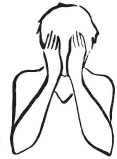
2. Eyes: Cup your hands over your eyes (your wrists may rest on your cheekbones, your fingertips on your forehead).
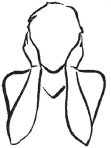
3. Ears: Cup your hands around your ears.
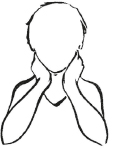
4. Throat: Place your hands with your thumbs on your collarbones, palms towards your throat. (Alternatively, place your hands either side of your neck.)
5. Heart chakra: Place your hands on your upper chest at the level of your heart.
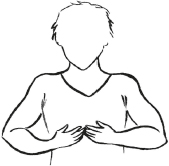
6. Solar plexus: Place your hands at the lower end of your ribcage.
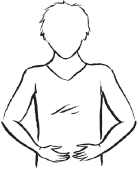
7. Navel chakra: Place your hands about 2cm (1 in) below your navel.
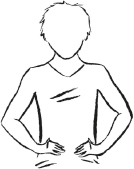
8. Root chakra: Place your hands on either side of your hips or more towards the centre of your body, whichever you prefer (after all, it is your own body).
9. In addition, you may place your hands on your back or legs, wherever you feel is comfortable and required.
Amazingly, Reiki can be used to treat other people straight away. Don’t let anything stop you! Some students go home after the first day of the course and try it out on their family. The feedback the next day is fabulous.
The term ‘treating others’ isn’t, however, wholly appropriate. We don’t really give a treatment, we merely open up to Reiki and share the connection with the client. Students often comment in surprise that after ‘giving a treatment’ they feel as if they’ve received one. And that is exactly what happens.
When we practise Reiki, we don’t use any of our own energy, we simply connect to energy from above. (Which is why some practitioners use the term ‘channelling energy’.) Unlike our own energy, Reiki is available in abundance. Sharing it will never leave us depleted.
In this chapter we will explore the basics of providing a Reiki treatment. They are always the same, no matter whether you’re a complete novice or a seasoned practitioner.
Everyone! Friends, family, the whole world. Although officially after Reiki 1 you’re supposed only to treat friends and family. But where’s the boundary? Isn’t everybody a friend in a way? The difference lies in money matters. As soon as you charge for a treatment (even for family and friends), you’re running a business. And for that you need to have public liability insurance. But as long as you do it for free, you can treat anyone you like (unless, of course, they don’t want Reiki).
At least, this is what applies in the UK. In other countries, including a number of states in the USA, where each one seems to have a different law concerning complementary therapies, you may find stricter regulation. It’s best to check it out before you place your hands on anybody! Some states, for instance, require a Reiki practitioner to be a licensed sports masseur before they can give professional treatments. If in doubt, you can always play it safe: simply place your hands a few centimetres away from the body. As long as there’s no touch involved, there are no concerns. And there’s no difference in the effectiveness of the treatment either.
Everything! Just to alleviate any doubts, I would like to repeat this: absolutely everything can be treated! There is no condition that will not benefit from Reiki. I’ve had students using it on people suffering with everything from back pain to cancer, bruises to dementia, alcoholism to relationship problems. One student treated the aching hands of her pianist husband straight after her Reiki 1 course. He happily resumed playing the next day.
There are also no exclusions when it comes to the conditions a recipient might have. Pregnancy, a pacemaker and medication are no reasons not to give Reiki. In the first case, you will be treating two in one; in the second, the machine will be assisted; in the last, the effects will be maximized and side effects minimized.
Reiki is not only popular because of its healing success but also because it is entirely risk-free. Used on its own, it cannot do any harm. And that’s official: the National Occupational Standards (NOS) for Reiki Practice in the UK state that ‘there are no known contra-indications to Reiki when used on its own’.1 The only side effect is spiritual development.
Still, many people find this difficult to accept. Deep in the recesses of our mind we have an ingrained fear that there might still be exceptions and that just this once something will go wrong. After a lifetime of negative conditioning, this isn’t surprising: with medical treatment, we are told that every remedy has side effects and all good medicine tastes bitter. If we aren’t suffering, we don’t think it’s working. In the moral and religious sphere, too, at least a certain degree of punishment is often expected, even from God. So how can Reiki be without any negativity at all? Well, it just is.
Sadly, there is a huge need to emphasize this, because people seem to be unaware of it. The internet, for example, is full of disconcerting stories and strange advice about Reiki. But all the stories start along the lines of ‘I heard of someone who…’ or ‘I was told that this or that happened…’ If you investigate more deeply, they turn out to be hearsay. Or simply assumptions.
Of course, in conventional terms it would make sense to check whether a certain therapy could have a negative effect on a client with a pacemaker, or suffering from asthma, epilepsy, diabetes or high blood pressure. For Reiki, though, this has all been tested. In fact, many practitioners have stated that they have found Reiki particularly helpful for the conditions just listed.
If there had ever been a verifiable problem with the use of Reiki, surely the NOS would not have used the above wording. And, frankly, I would have walked away from it. I practise Reiki because I trust it completely. Obviously, insurance companies do too: if the premium for public liability insurance is an indicator of risk, it seems they consider Reiki entirely risk-free. The policy for Reiki costs a fraction of those for many other therapies.
The worst thing that can happen when giving Reiki is that the recipient doesn’t feel anything. If this is the case (although it’s quite rare in my experience), don’t get too frustrated. If other people feel something and this person does not, there must be a reason for it. Maybe they aren’t ready to face change. Maybe they are consciously or subconsciously resisting the treatment. Personally, I wouldn’t spend too much time worrying about it. You have offered Reiki and that is all you can do.
Before we get started with the actual treatment, we need to make some preparations. This is my suggested ‘to do’ list:
A treatment can be given anywhere: on a bench in the park, on a towel on the beach. Basically, wherever you are. But in most cases you would look for somewhere quiet and sheltered. I tend to find that the best place for this is home – either yours or the client’s. There’s no need for a separate treatment room. When I started my practice, I simply moved the sofa and TV to the side of the room and placed the treatment couch in the middle. I never had a client who felt this was inappropriate.
If you aren’t comfortable inviting potential strangers into your home, you may want to make sure that a family member is also present in the house. Or you could rent a therapy room. In many complementary therapy clinics, rooms can be hired by the hour – just shop around to get a good deal.
Now you need a place for the client to lie down comfortably. This can be on an armchair, sofa, bed, sturdy dining table or even yoga mat on the floor. Some clients might prefer to sit. That’s also fine. Just make sure that you are comfortable, too. You may have the best of intentions, but leaning over in an awkward position or kneeling down on a hard floor isn’t ideal. By the end of the treatment you will find yourself in need of Reiki too. So make sure that you have something to sit on (maybe a cushion on the floor) and check your posture. If you happen to find that you are uncomfortable at any time during the treatment, you can always lift your hands for a moment, adjust your position and then put them back again.
If you give treatments regularly, you may want to consider investing in a treatment couch. Most of them fold away and are light enough to carry. There are many surprisingly cheap offers available. Any therapy couch will be fine, but if you go for a dedicated Reiki couch you will have the benefit of no crossing bar at the head and foot end, which allows you to sit slightly closer to the client. Some even come with a stool.
It is good practice to cover the client with a blanket, as often the body temperature drops when we relax. I even cover clients in summer (just using a simple sheet), as I don’t want the sensation of Reiki energy being confused with body heat and touch on naked skin.
Your home (or wherever else you are giving the treatment) now transforms into a healing space and you may want to spend a moment preparing it appropriately. This doesn’t mean you have to redecorate or move half of your furniture! Some tidying and airing will be perfectly fine. Some practitioners also light a candle or an incense stick or burn essential oils. Just be careful not to overdo it, as some clients’ senses heighten during the treatment. You don’t want them to start coughing because of your lavender oil.
Finally, make sure to switch off all phones and any other noise-making devices you may use. Although not a disaster, it tends to be a bit disconcerting when a phone rings in the middle of a treatment.
It’s a good idea not to chew on a raw garlic bulb just before the treatment. However healthy this may be, leave it for afterwards. Pouring a bottle of perfume over yourself is also a bit much. Just washing your hands will be perfectly fine.
What you wear is entirely up to you – there’s no need for any special clothing. The practical aspects are more important: you want your clothes to be comfortable. Also, you may get warm or cold after a while, so dress in layers and have a cardigan handy.
It’s also a good idea to take off any chunky pieces of jewellery. You don’t want them dangling in your client’s face.
Finally, do you need to protect yourself during a Reiki treatment? The answer is a clear no. I am aware that this is contrary to what is often published, but I have never used any kind of protection before giving a treatment. I’ve never even thought about it! Reiki is pure light – there’s no room for any shadows. We’re not inviting any negative energy in during a treatment – all we’re doing is releasing it. We may notice fear and trauma coming to the surface – but we can rest assured that Reiki will deal with it.
A first-time client is often rather nervous. They don’t know what to expect and may have had unpleasant experiences with other therapies. But even if they’ve had Reiki before, it’s still good to remind them of the basics:
Finally, make sure to ask before the treatment whether the client would like you to place your hands on their body or keep them slightly away.
With regards to physical touch, the following considerations apply:
You cannot overdo Reiki, but you can underdo it. As it is impossible to do any damage with it, in theory a treatment can be given for as long as you like. The recipient will automatically stop to ‘draw’ the energy when they’ve had enough for the moment. In most cases, however, it isn’t necessary to give a treatment for longer than 30 minutes (for a specific area of the body) or 45 to 60 minutes (for a full treatment) at a time. (If you are treating a very serious condition, it’s not a problem to give Reiki for longer, or several times during the day.) As Reiki stimulates the body’s innate self-healing abilities, the body also needs some time to rest and heal after treatment. After a few treatments, you’ll intuitively know when you can stop the treatment.
A single treatment can work wonders and result in physical healing or a change in perception. This happens surprisingly often in fact. You and the recipient may then happily leave it at this one appointment. But in other cases, more treatments are needed – maybe two or three, maybe 30 or 100. Don’t give up if the first treatment doesn’t bring complete healing. When Hawayo Takata gave treatments for severe or chronic illnesses, after a few weeks she often offered to teach a family member Reiki so that they could carry on giving treatments for the next month or two. Healing can take time. Most illnesses don’t appear overnight. Undoing them can be a lengthy process too. So, if the result you’re hoping for doesn’t manifest immediately, just carry on. Reiki should only be stopped when the symptoms are gone or you have other results that are sufficient.
I’ve occasionally found that even a few minutes of Reiki can do the job. Miracles don’t have a time-frame. But generally I would say that a five or 10-minute treatment isn’t really a treatment, it’s a taster – or an emergency treatment. It’s great to start with, but hopefully the recipient will come back for more. Even in our fast-paced lives, we should give Reiki the time and respect it is due.
…is one that doesn’t go to plan. But don’t worry – you can leave everything to Reiki. It’s perfectly safe. Let intuition take over and just accept that whatever this treatment brings is whatever is right for the client at this moment.
And yet, for all this, giving your first Reiki treatment can be a bit nerve-wracking. You look at this person in front of you and suddenly think: What have I got myself into? This person is here to get a Reiki treatment – from me!
I was very nervous when I gave my first Reiki treatment. Would I do everything correctly? Would the person feel anything? You might feel the same, but again, don’t worry. Reiki is doing without doing.2 It isn’t about you, it’s about Reiki. The more we simply accept this, the more open we will be, and the more Reiki will be felt.
Reiki practitioner Pamela Miles writes: ‘…as I have practised over two decades, it’s become obvious to me that the less I do and the quieter I am inside, the more room there is for Reiki.’3
Giving a Reiki treatment ultimately boils down to two simple steps:
The first we do by intention, the second by intuition. That’s all.
Having said this, though, it’s both possible and helpful to elaborate on these basic steps. If somebody bruises their shoulder, we connect to Reiki and of course place our hand straight on the shoulder. As we would in an emergency. But for a normal Reiki treatment, most people would add a few more steps. This is the classic sequence:
As most likely this will be the basis for giving Reiki treatments for the rest of your life, I will now go into it in much more detail. A step-by-step example of how I give a treatment is shown on the following pages. But again, it’s not a rigid structure. Please take it as a guideline – and develop your own routine.
Before we start, one last little piece of advice. This question often pops up on my courses: ‘Do you need to think of something specific?’ No – and yes. If, as soon as you start the treatment, you mentally create a ‘to do’ list for the week or start thinking of your tax return, you’ll be too distracted. Most likely neither you nor your client will feel much Reiki. Needless to say, you wouldn’t do this anyway…
The best way to approach the treatment is to focus on your hands. Do you feel a sensation? Does it change after a while? Do you get any ideas about the condition or the person you are treating?
And don’t try too hard. I often just sit and enjoy the wonderful sensation of feeling connected. Soon you will enter a meditative state. A few of my students call it ‘Reiki Land’.
After a few treatments, you won’t worry about this anyway. Reiki will just take you to where you need to be. Yet it’s not always easy to stay alert for an entire hour. Occasionally you may find your mind wandering off. Don’t worry if you’re distracted for a moment. Once you do notice it, gently bring yourself back to Reiki and carry on. Reiki will have carried on.
My student Dee provided a brilliant example of this. She gave Reiki to her husband, who had dislocated his shoulder in a motorbike accident. It was so painful that he could only bear it being touched when his wife used Reiki. One evening, lying in bed, she reached over to place her hand on his shoulder and give him some more Reiki. Then she nodded off. A few minutes later, he started to call out: ‘Wake up, wake up! It’s getting too warm!’ Even though the practitioner was asleep, Reiki had just carried on working…
From experiences like this, I conclude that intention is a major factor in using Reiki. It almost seems that we enter into an agreement with the universe when we decide to use it.
So, finally, let’s start the treatment.
The client is now comfortably placed on whatever is available: sofa, bed, yoga mat, sturdy dining table or professional treatment couch. (Please be sure to place a cushion under their knees to alleviate any strain from the lower back.) Ask them to close their eyes so that they can relax. Then get ready yourself:
I start with dry bathing (Kenyoku-Ho) or a Reiki shower to remove any mental or physical energy blockages and then take a moment to calm down and relax. Take as much time as you need. Your client is happily lying down and won’t mind waiting another minute or two.
Do this in whichever way is best for you. I place my hands in Gassho for a moment to centre myself, then set my intention to give a Reiki treatment.
I just state to myself (and to the universe): ‘I intend to connect to Reiki.’
Wait until you feel the Reiki energy. This is very important. Take your time. You might feel a sensation in your palms or simply have the awareness that you are now connected. (Deep abdominal breathing can help here.)
Standing beside the client, I slowly lower my hands, intending to make a connection with the client’s aura/energy body. I spend a moment sensing this. (If this step causes any difficulties, just leave it out. It is by no means essential.)
After this, I finally place my hands on the body (or slightly away from it, whichever has been agreed and is appropriate). There are several options:
Even if you are following a set sequence of hand positions or the client has asked you to place your hands on a particular area, still listen to your intuition. It‘s perfectly fine to end up using only one or two hand positions for the entire treatment. In fact, I tend to find that a very quick succession of positions indicates that the practitioner is rather inexperienced and hasn’t learned to trust their intuition yet.
Before I finish I spend a moment sending Reiki into the client’s aura. I don’t think many practitioners do this, but I like to sense the connection with the entire ‘energy person’ at the end of the treatment. I slowly raise my hands with the intention of bringing Reiki into all the layers of the aura.
At the end of a treatment most practitioners ‘smooth down’ the aura. To do this, the hands are moved over the body from the head to the feet (a bit like stroking a pet, only with the hands a few centimetres away from the body). This is normally done three times. The idea behind it is that stale energy may have been released during the treatment and needs to be cleared out of the body. But don’t worry if you forget to do this – I’m sure the stale energy will disappear of its own accord. After all, you’ve just given Reiki!
You now need to make the client aware that the treatment is over and bring them back from their wonderfully serene and peaceful state. Or, if they are asleep, wake them up. In either case, you need to be gentle (a bucket of cold water is not ideal). I normally place my hand on their shoulder and tell them in a low voice that the treatment is now complete and they may take as much time as they need to come back to the here and now. Or I use the backstroke, applying gentle pressure with the knuckles of my index and middle fingers on either side of the spine (not in the middle!) and making three swift movements towards the lower back. This technique is used in many hands-on therapies.
I then place my hands in Gassho for a moment and thank Reiki. After all, it wasn’t me who gave the treatment – I was just lending my hands.
Dry brushing concludes the treatment. This grounds me and brings me back to the here and now.
You should offer the client a glass of water after the treatment (to help flush out any toxins released from the body) and advise them to drink plenty of water for the rest of the day (for the same reason).
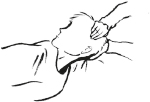
1. Top of the head: Standing or sitting at the head end of the treatment couch, place one of your hands underneath the client’s head and the other on the crown. (Alternatively, or if you are giving a hands-off treatment, place both hands on or near the crown.)

2. Eyes: Cup your hands over the eyes (your wrists may rest on the client’s forehead).
3. Ears: Cup your hands around the ears.
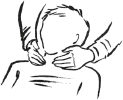
4. Throat: Place your hands with the little fingers on the collarbones, palms towards the throat. (Alternatively, place your hands either side of the neck.)
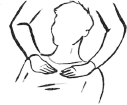
5. Heart chakra: If you can lean forward further, place your hands on the upper chest of the client. Otherwise, stand beside the client.
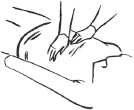
6. Solar plexus: Stand beside the client and place your hands at the lower end of the ribcage.

7. Navel chakra: Place your hands about 2cm (1 in) below the navel, roughly where a belt would be worn.

8. Root chakra: Place your hands on either side of the hips.
Now you have a choice: in the Western tradition, the client is asked to turn over and lie on their front. But if this is difficult, or they don’t want to, you may carry on with the treatment with the client lying on their back. (In this case, the next positions are the thighs, the knees, the shins and the feet.) If the client does turn over, please move the cushion to the ankles and position your hands as follows:

9. Shoulder blades: Place one hand on each shoulder blade.

10. Middle back: Place both hands halfway between the shoulder blades and the waist.
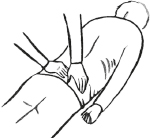
11. Waist: Place your hands on the back at waist level.
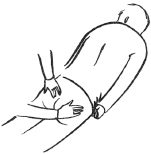
12. Buttocks: Place your hands on or above the buttocks.
And that may be exactly what you say next! Did it work? What really happened?
Wait for your client to come back into the here and now and then start to make some sense of their experiences. Although both of you, practitioner and client, will have had experiences, I tend to ask the client first what they want to share.
The more treatments you give, the more you’ll start to see some patterns in the effects they have. And yet no two Reiki treatments are exactly the same. Every treatment teaches us something new. Here is my personal – and by no means exhaustive – list of the effects you may encounter both during and after a treatment. They are meant for reference – and to help you make a bit more sense of the experiences you will have.
Probably the most unexciting result! But Reiki tends to have a relaxing effect and clients fall asleep quite frequently. (The first ones to do so are normally those who complain that they have sleeping problems.) As sleep is a natural healing state for the body, I usually leave them to snore away happily. If the snoring does get too much, you can always gently place your hand on their shoulder and ask them to move, maybe to lie on their side or front so that falling asleep again will be a bit more difficult. I am certain, though, that a Reiki treatment is just as effective when the client dozes off…
Even clients who don’t fall asleep often comment that they were ‘drifting off’ during the treatment. If they are used to meditating, they may describe this as a familiar meditative state; if they are new to it, they tend to talk about ‘a happy place’ or ‘a peaceful place’ or ‘a floating sensation’. It is the start of leaving the restrictions of our physical existence behind and experiencing our spiritual being.
Most recipients feel a strong sensation of heat in the area where the practitioner’s hands are placed. Some even feel this as uncomfortably strong. (It can be eased by slightly lifting the hands.) Others experience the opposite: a localized sensation of cold. Both mean the same: Reiki is at work. Other signs of this may be tingling, slight numbness and heaviness. Occasionally, even a localized sensation of pain can occur. None of this is anything to worry about; it all shows that something is shifting in the body.
…comes in different shapes and sizes: sudden body movements, coughing and crying are all signs that physical or emotional tension is being released. So don’t worry if your client suddenly starts sobbing. Just offer them a tissue and ask them to take their time in composing themselves. You can then either continue the treatment or decide that the objective has been achieved (no, not making them cry, but bringing something out that stirred those emotions) and leave it for the day. Just ask them what they prefer.
Some clients may even start to laugh. That’s a great way to feel better – simply join in!
It can happen that a client arrives bothered by a non-physical problem – and suddenly comes up with a smart solution.
Many people see colours and shapes, often resembling slow-moving works of abstract art. Of course, colours and shapes are ways of perceiving the movement of energy visually.
Some people see a particular image – a tree, an animal, a house, a car or a star, to name but a few. Some even see abstract symbols similar to the ones introduced in Reiki 2.
One of my Reiki 1 students saw the image of a pansy appearing during the first Reiki treatment she received from a fellow student on the course. Strangely, the pansy didn’t have any dark inner areas and was completely golden in colour. After some soul-searching, the student decided it must be a sign that she should spend more time in nature, echoing an urge she had already had for a while. Running a bit late the next morning, she missed her train and had to wait half an hour for the next one. When she finally got on it and sat down, she looked out of the window and saw a large lorry approaching. On it was a big logo: a golden pansy (without the usual black inside) on a green background. Next to it was a slogan: ‘Closer to nature.’ What a fabulous example of synchronicity!
Occasionally clients see an entire story unfolding in front of their closed eyes, just as if they were watching a movie. This can have a dream-like quality and often makes sense only days or weeks after the treatment, when it either takes place in reality or they suddenly get an idea of its meaning.
When memories come up (often as if they are being relived rather than remembered), they are usually not of recent experiences but long-forgotten ones. This means the person is now ready to deal with them.
It’s not unusual for clients to feel a non-physical presence during the treatment. This may be a guide or angel, or a friend or family member saying hello from the spirit realm. I’ve had several clients mention having complete conversations with their mother or father who had been ‘dead’ for many years.
Some even feel they are leaving their body. They feel weightless and unrestricted by the physical limitations of their body.
And if little or nothing of the above happens and the client simply reports a feeling of relaxation, that’s perfectly fine. The other experiences are only listed because they may happen – and I don’t want you to freak out if they do. They are perfectly normal – but not necessary. Healing will take place even if neither the client nor the practitioner feels very much at all. Just wait for the feedback a while later!
In many cases, clients find that the physical problem they are suffering from has improved. Sometimes dramatically.
In other cases, the opposite happens. Although initially perplexing, this so-called ‘healing crisis’ is a well-known effect in many therapies, not just in Reiki. It means that something is shifting and the physical healing process has started, although the initial efforts are causing pain. It’s similar to the sensation when we cut ourselves: we look at the bleeding wound and don’t feel anything at all. We put it under cold water, apply a plaster – and suddenly the pain kicks in. This is when the actual healing starts.
A healing crisis can last between an hour and a day, but not longer. Experienced Reiki practitioners just smile when somebody complains about feeling a bit worse after the treatment and reassure them that they will feel the opposite soon.
In many cases, the immediate effect is only subtle – barely noticeable – as the body needs some time before the big change happens. Often the main improvement takes place over the following day or two. The long-lost virtue of patience comes in handy here.
It can also happen that a client comes out of a treatment with a clear idea of what they can do to resolve a problem (physical or otherwise) and/or what (often seemingly unrelated) caused it in the first place.
Some clients look slightly dazed after the treatment. They mumble words like ‘weird’, ‘strange’ or ‘odd’ and need some time to digest what’s happened to them. I suggest they drink plenty of water, have some fresh air and spend some time on their own. Encouraging them to do dry brushing (see Kenyoku-Ho (Dry bathing)) will also help them to come back to the here and now more quickly.
In a similar way to a physical healing crisis, it may happen that a client feels emotionally unwell. Some feel sad, some even angry – not about the treatment but about a memory that has surfaced. This will be something they now have to deal with. But the fact that it has come out means they are able to do this – and of course they have the support of Reiki.
And again, the opposite may happen: sometimes a client just oozes happiness, relief and wellbeing.
Whatever a person is suffering from, Reiki can have a huge impact on:
Either consciously or subconsciously, the Reiki client may implement changes to their lifestyle.
People often have noticeably more strength to deal with life.
People see things in a different light, change their attitude, have more understanding and can accept and forgive others.
A Reiki treatment starts a cleansing process in the body in a similar way to an attunement (see A 21-day clearing process).
Miraculous changes can happen around a person who has had a Reiki treatment. Synchronicity arrives…
Sometimes Reiki sets a whole chain of events in motion. A practitioner friend of mine, for instance, gave a treatment to a man in his thirties. Although his strong physique and positive attitude would not normally have suggested this, he suffered from regular panic attacks with severe breathing problems. He received a full Reiki treatment, and his girlfriend, who had accompanied him, had a shorter one. The practitioner noted a lot of Reiki being drawn into the man’s chest and held her hands there for longer than in other positions.
Driving home, the man suddenly suffered another panic attack. Luckily his girlfriend was able to take over and drive him straight to the nearest hospital. She knew how relaxed they both felt after the Reiki treatment – this couldn’t be a panic attack!
As usual, though, at A&E the man was diagnosed with a panic attack. He was about to be sent home when his girlfriend stepped in, told the doctors about the Reiki treatment and that she didn’t believe that a panic attack could happen straight afterwards, and insisted on a proper check-up. A blood test then revealed a potential problem: the man was so dehydrated that it was difficult to extract any blood at all. Finally alerted to the fact that there was a serious issue here, the doctors ordered an MRI scan and discovered three blood clots in the lungs.
Half an hour later my friend received a text message from the girlfriend: ‘You saved his life!’ The man could now receive the correct treatment. Two months later he went back to work.
Even if Reiki doesn’t seem to work, we may discover a hidden reason why. I once used it for a slipped disc in my back. Thirty minutes later the pain had almost gone and the neck had somehow readjusted itself. When I tried to do the same with my painful right shoulder, it didn’t work.
Reluctantly I saw my GP, who prescribed physiotherapy. Being shown how to correct my posture and given some simple exercises really helped me and the pain disappeared. Had I not seen the therapist, I would have carried on sitting in the wrong position and given myself the same problem again and again.
When you give a treatment, you’re working within the client’s energy field. It is therefore highly probable that you’ll have the same experiences they do. Sometimes you may even feel their problems in your own body, for example a pain in your left leg or your chest. This is nothing to worry about: you won’t take on their problems, simply experience them for a brief moment. Experiences like this are a way for you to draw on your intuition and use it to shed some light on their condition.
On very rare occasions you may also come across another phenomenon: you may need Reiki more than your client! A few times on my courses the recipient has had an insight – about the practitioner.
Unsurprisingly, many clients are slightly confused after the first treatment. Amazed, but puzzled. They will need some time to come to terms with the experience. Some choose to spend some time by themselves – and may leave rather abruptly. Don’t take this personally, it’s just a coping mechanism. Even if your client does stay around for a while, it’s good to recommend spending a few moments outside in the fresh air. Other clients, however, feel the urge to talk.
Faced with an array of unusual experiences, they may ask you for explanations.
Here are a few words of advice on this:
‘Why did I see red?’ a client might ask. ‘What does the image of a tree in bloom mean?’
I tend to ask back: ‘What do you think it means?’
Often the client will then intuitively come up with an explanation. If not, use your own intuition. Don’t make something up, though – if you don’t have a firm idea, just ask the client to be patient. I tend to find that an explanation arrives a while later. Occasionally, though, the client just has to accept that whatever they saw was an experience – and leave it as such.
Many people can easily spend an hour or more discussing their experiences. But that isn’t the point. The experiences were there to be experienced. Afterwards, the client should allow themselves some time simply to digest them.
The one thing a Reiki practitioner is not allowed to do is to diagnose an illness. If you suspect that a problem is of a physical nature, simply say that you felt a lot of Reiki being drawn into a particular area and suggest that the client has this checked out by a doctor.
They may – but they may be completely different. As I explained earlier, a cure isn’t always what we get. In many cases it is, so please don’t be disheartened if it doesn’t happen immediately. Reiki is very much about physical healing. Only it doesn’t stop there. Healing isn’t always curing. So, if you don’t get the results you hoped for, try to accept this and understand what is happening.
When we give a Reiki treatment, we do it for a purpose. Whether it’s for ourselves or for others, we hope for an effect, we hope for healing – basically, we hope for an improvement in our current situation. We hope for physical, emotional and circumstantial change. And, as I never tire of repeating, Reiki does tend to bring this. But healing can come in an unexpected package and there may be something of a process involved.
So that’s the perfect Reiki treatment. And you can give it to anyone – can’t you?
Of course you can. As I mentioned earlier, the only reason not to give Reiki is that someone doesn’t want to receive it.
If a client has a heavy cold or any other contagious illness, however, you should take the normal precautions not to catch it yourself.
Also, there are situations in which Reiki must only be given in addition to other treatments:
But this is all common sense – and hypothetical, as normally in these cases a person would see a GP or emergency doctor anyway.
Reiki is an alternative as well as a complementary therapy. The decision about how to use it can only be made by the client.
Many people use it as a complementary therapy – in other words, complementing traditional therapies. This is perfectly safe. Reiki can be given before, during or after surgery and alongside any medication. It can even be given to the medication in order to minimize side effects and maximize results. Often clients need smaller dosages as a result.
If people don’t want conventional treatment, they may seek Reiki as the sole therapy. A friend once asked a Reiki practitioner to send Reiki while she had dental work done – and managed to get through the process without anaesthetic. If a client wishes to have Reiki instead of a major conventional treatment, however, the practitioner should get written confirmation from them (see Reiki as a professional practice).
Of course, Reiki can also be combined with other alternative therapies. Personally, I would always use it on its own first. If you then feel drawn to combining it with other modalities, this is up to you. But I tend to find that once it’s been tried, there’s often no need for anything else.
A Reiki treatment can also be given without the hands. Although in practice the following techniques are rarely used, they may come in handy (sorry!) when using your hands isn’t appropriate or possible.
Apart from the seven main chakras, we also have chakras in our palms and on the soles of our feet. Students frequently feel their feet getting hot during an attunement – a sign that these energy centres are being activated.
Mikao Usui is said to have used his feet in addition to his hands when he treated the injured after the Kanto Earthquake.
There are no traditional rules for using your feet for a Reiki treatment – just follow your intuition (but of course don’t actually stand on the other person).
For this technique you share Reiki with others through your aura.
Mikao Usui is said to have sometimes also used light patting or stroking movements to clear blocked energy. As these techniques count as body manipulation, they are not normally used today. Only a doctor or massage therapist would legally be allowed to use them.
Basically, there’s nothing that won’t benefit from Reiki. Just play with it – be creative. Here are some suggestions:
If you have a pet, I’m sure you love it just as much as I love Lady, my greyhound. And you’ll want to give it Reiki too. Well, of course you can!
Lady ran away once in a thunderstorm. The first thing I did was to send Reiki after her with the intention of keeping her safe. Then I started to look for her – initially on foot, then by car (greyhounds are rather fast). I searched for 15 minutes, but there was no trace of her. All I could do was wait (and send more Reiki). Nevertheless I felt strangely calm and somehow knew she would be fine.
Luckily, she was wearing a tag with my phone number on and half an hour later a call came. She had been found – five miles away! She must have crossed many roads – and she doesn’t stop at the kerb even when she isn’t afraid.
I got her back safely and took her straight to the vet. Her paws were covered in cuts and blisters – the skin was just hanging down. But after three days of Reiki she started running around again – the skin had almost completely healed.
To treat a pet (or in fact any animal), you don’t need to follow a particular sequence of hand positions. All you do is intend to give them Reiki when they cuddle up on your lap, or place your hands on or near the area in need.
You may even find that they suddenly come up to you and make you aware that they would like Reiki! One student was completely puzzled when his neighbour’s rather frosty cat suddenly came up to him and started to purr. Then it occurred to him that it was sensing his Reiki connection.
If you have a hamster or bird or any other little creature in a cage, you can just place your hands on the outside of the cage to give Reiki. And if you’re in a zoo, there’s no need to enter the tiger’s enclosure. Just beam Reiki from a distance.
Treating animals professionally is more regulated than treating humans. Please make sure you familiarize yourself with the regulations before you charge for a treatment!
One lady told a Reiki Share about a rose bush in a pot that her mother had suggested throwing away as it was ‘dead’. After a few days of Reiki (and water, of course) it came back to life. Just like the chilli plant that I rescued from negligence in a supermarket. After two weeks of Reiki it produced chillies on an almost industrial scale. I even put them in scrambled eggs.
You can give Reiki to seeds and indoor plants as well as to fully grown trees or even your entire garden. How do you do that? Just use your imagination – and maybe give Reiki to the watering can…
As we learned earlier, everything is energy, so it follows on that everything can benefit from Reiki. I have given Reiki to my computer and printer (it finished the printing job before it died), car (it lived for three years after being given up on by the local garage) and mobile phone. Currently the dishwasher gets some.
And it even came in handy in convincing a London Underground ticket machine to accept my coins and issue the ticket.
Don’t think, Is it OK to use Reiki for this? Just do it. Reiki doesn’t judge.
You can give Reiki to the ingredients before you cook, send it while stirring the soup or add it just before serving.
Or you can do the ‘purifying water’ test: fill two jugs with tap water, give Reiki to one of them for a few minutes and let your guests taste the difference. Reiki seems to harmonize the chemical balance of the water.
If you feel you would like to use Reiki to protect yourself from negative energies, there are various visualizations to choose from – or simply use intention.
There are several ways of using intention:
Among the visualizations are:
There are many more visualizations, or you can make up your own. A visualization is simply a way of helping you become aware of the Reiki around you and open up to it.
As mentioned earlier, protection is not necessary for a Reiki treatment.
Although a proper ‘distance treatment’ can normally only be given after Reiki 2, even after Reiki 1 you can send Reiki to a person who needs healing.
Think of the person, then write down their name or find a photograph of them. Connect to Reiki and either hold your hands over the name or picture or just ‘beam’ it to the person you are thinking of.
That is exactly how I use Reiki: for anything and everything that comes my way! I give it to an email before I press ‘send’, to a website before booking a flight, to the plane when I get on board.
Try it out for yourself and see how it works for you…
The use of Reiki isn’t even restricted to beings or objects – it can also be sent to situations.
Can you think of a personal situation that would benefit from Reiki? It can either be occurring now (your best friend is having a job interview) or in the future (you have to ask your difficult neighbour to lend you their lawn mower).
There are three simple steps:
Alternatively, you can write the situation down (a few words or bullet points are enough), then place your hands over the piece of paper and give it Reiki.
In both cases, send Reiki for as long as you feel a strong sensation in your palms or simply until you feel that you’ve sent enough. This can take anything from two to 20 minutes but won’t normally be longer. After that, stop worrying about it – and let the universe do its work.
Of course the same principle applies as for physical healing: what we wish for may not be the right thing for us. But sending Reiki often works wonders. My own circumstances changed dramatically when Reiki came into my life!
A student of mine was sitting at home one day searching for ideas on how to get further funding for a charity she was involved in. Stuck for inspiration, she decided to give the situation Reiki. She got out the charity’s cheque book, placed a leaflet on top detailing all the good work the charity did and placed her hands over it to give it Reiki.
She had just rented out a room in her house and the next evening her new lodger asked her out for a drink so they could get to know each other. Of course my student talked about her involvement in the charity and it turned out that her lodger worked for a big corporation which happened to have its own charitable arm supporting the projects of small charities. It wasn’t difficult to come up with an idea for a new project – and two months later the funds arrived. It was the story of the day at the following Reiki Share!
Once you’ve taken Reiki 2, using the Connection Symbol will greatly increase your ability to connect to situations, as we’ll soon see.
Of course, we don’t just face personal problems – the whole world is full of them! So, if you feel guided to do so, you can also send Reiki to world situations.
It works just the same: connect to Reiki, think of the situation and send Reiki there, either through intention or through placing your hands over a picture or article or description of the situation. I occasionally find myself simply sitting in front of the news screen on my computer and sending Reiki to the situation I’m reading about.
Unsurprisingly, it’s more difficult to judge the effects of Reiki on such a scale – and we may find the sheer quantity of problems so overwhelming that we don’t know where to start and when to stop. It seems to me that first and foremost we are responsible for our immediate environment. Friends, family, neighbours and colleagues are those who can be reached most easily – as well as ourselves, of course. But if you feel guided to send Reiki to a situation on a larger scale, just follow your intuition. I tend to find that we just know when to send Reiki – and when to leave events to unfold.
Occasionally, we might get an idea of the eventual outcome. When I heard about the earthquake in Japan in 2012, the parallels to the one in 1923 were immediately clear. Although, with the epicentre under the sea, it didn’t claim as many lives, the effects of the ensuing tsunami, especially on the nuclear power station of Fukushima, had the potential to cause even greater devastation. Every 30 minutes I checked the news on my smartphone – and felt I had to do something. Of course, Reiki was my only tool.
When I started sending Reiki, it was unclear what was going on inside the nuclear reactors. The worst-case scenario that everyone hoped to avoid was a nuclear meltdown due to malfunctioning cooling systems. When I started to connect through Reiki, I suddenly saw that in two reactors the meltdown had already happened. But it was accompanied by a surprising sense of calm, giving me the impression that the consequences could, to a large degree, be contained. A few hours later the news confirmed the meltdown – and over the following weeks it became clear that it had been possible to contain a major outbreak of radiation.
I certainly don’t want to claim that this happened because I (and many others as it turned out later) sent Reiki to the situation. And yet, who knows? It certainly was pretty amazing to get a glimpse of the outcome.
Reiki need not be a solitary pursuit – practitioners often get together in groups, particularly at Reiki Shares.
Many Reiki teachers offer Reiki Shares for their students. These normally consist of a short talk on a Reiki-related subject or a discussion of experiences, a meditation and/or breathing exercises, and often a Reiju (energy blessing) from a Reiki Master. This is followed by a group treatment (see below).
Reiki Shares are a great way to stay in touch with like-minded people and to share experiences. If your Reiki teacher doesn’t organize them, just do it yourself. Get your fellow students together. Or utilize social media. Or search for a Reiki Share in your area.
This is where two or more practitioners give Reiki to a person at the same time. They either place their hands on different parts of the body or, if they all feel guided to the same place, one hand on top of the other.
In a very large group, this can be done in circles, with people in the outer circles placing their hands on the shoulders of the people in the circle in front of them.
This technique can be used at a Reiki Share or to increase the awareness of energy whenever a group of Reiki students comes together.
While on the subject of groups, if your friends or colleagues ask you to explain Reiki, frankly I wouldn’t even try. After all, I need over 100 pages just to explain the basics. And you would need to cover energy, hands, healing and enlightenment! Instead, simply offer them a taster treatment.
The following hand positions are a great sequence.

Head-only treatment